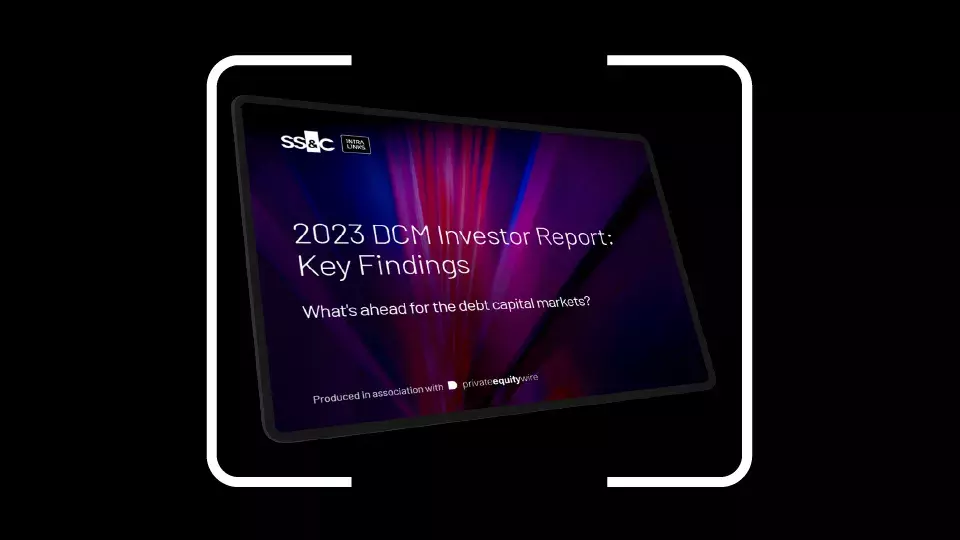For global capital markets, 2022 was one of the most challenging years on record. As macro-economic factors begin to shift in 2023, the opportunities in debt capital markets (DCM) are starting to look positive for investors who have the capital to allocate — if the investment is creative and unique. These opportunities are currently coming at a higher cost and with more in-depth due diligence.
I recently joined a webinar about the outlook for debt capital markets from a North American perspective. Also on the panel were Christopher Freeman, managing director at MUFG Direct Lending and Rob Deckey, managing director at Invesco Real Estate.
Christopher believes that 2023 should be better than 2022 and recent events are allowing him to be more hopeful: “With energy prices moderating, China reopening and inflation starting to ease off a little, there is some light at the end of the tunnel.”
I echoed this positive outlook, noting that Intralinks clients appear to be cautiously optimistic at the beginning of 2023, with specific sub-sectors of the debt world expected to sustain profitability and outperform in times of high inflation or volatility. These would include sectors like Finance, Infrastructure, Energy and Oil.
Within this context, debt investors have a so-called clean slate, in that they have several attractive entry points into the market, from a yield perspective.
According to the 2023 SS&C Intralinks DCM Investor Report — a survey of the allocation plans and return expectations of 134 institutional investors for the next 12 months — institutional investors are planning to allocate more funds to debt capital markets this year. They are interested in investment-grade credit, public bonds and private bonds as well as structured products given the flexibility they provide during uncertain times.
Lenders are coming back to the market after being in a slumber in the fourth quarter of 2022. Christopher noted: “Lenders are becoming more willing and more available, but at a much higher cost. The costs are probably higher than they've been in most of the last decade, given the base rates and spreads are still pretty elevated. So, we do think supply will outstrip demand in the first half of this year.”
Rob shared that this is the case in the real estate sector: “There is no lack of liquidity in the marketplace; there's over USD 300 billion of real estate, private equity money and all the debt funds are flush with cash. It's just that financing costs are painfully expensive, and people aren't willing to sell at the lower prices to make the math work.”
At some point, corporates and borrowers will be forced to face the debt that is due — which they cannot refinance, or they will need to sell and liquidate assets to execute business plans.
Elaborating further on the rise in costs, Rob said that 2022 was the first time in his memory that both interest rates and credit spreads went up, making financing twice as expensive. However, he is positive about the future of DCM: “Now we're seeing credit spreads come in. If they continue to come in, we’ll see more issuance. As we enter the second quarter [of 2023], and fundamentals in both the economy and capital markets continue to remain in balance, I think we'll see a positive second half [of] 2023 in terms of issuance, financing costs and a return to some normalcy in activity.”
Slower dealmaking expected
Christopher said he believes the second half of 2023 will see some form of a recession and issuance to be muted: “The outlook is a little choppy right now. Virtually everybody expects there to be some sort of recession this year; probably one of the most telegraphed and predicted recessions in history. Our house view is that that's going to be shifted out to the back half of this year.”
How deep and how long the eventual recession will be is dependent on the movements of the Federal Reserve and also on investor sentiment and behavior. For example, investors with a highly leveraged private debt portfolio need economic growth to drive revenue and cash flow, so for these investors, a “stagflationary” environment is the worst possible outcome.
From the Intralinks perspective, I shared that there has been an uptick in investors or institutional investors allocating to private debt. This is consistent with our DCM Report, which cited that 56 percent expect to increase those allocations over the next three years.
In terms of Real Estate, Rob pointed out the significant diversification that has taken place in property types: “In the public REIT sector, non-traditional property types now make up 60 percent of the market capitalization. We're seeing this increasingly in the CMBS and debt markets.”
These once niche sectors have now become quite mainstream which is indicative of a shift in risk — both in terms of investor appetite and of investment types being offered.
More broadly, Christopher expects a tepid demand for debt, but investors who have the capital and have a mandate to grow will find some good opportunities in the market: “The environment continues to sit in favor of the lender as opposed to the issuer, though I believe this is going to change with supply coming back to the market and demand being a bit muted.”
Deeper diligence
The slower-paced dealmaking environment is allowing investors time to dig deeper when it comes to due diligence. Many Intralinks clients are readying themselves for a shift in the environment. The advisors and banks I’ve been in touch with are getting their diligence materials ready but are really holding out for the optimal moment in the macro environment. They are aiming to be efficient and optimized so they’re ready to strike when dealmaking does pick up.
Further, the market is grappling with the fact that many resources have been taken off the table — for example, the repercussions of cost-cutting measures employed across many industries. This underlines the importance of productivity tools, software and services that increase efficiency and security and allow dealmakers to focus on higher-level tasks.
Technological advances have brought significant efficiencies to DCM, particularly those platforms that allow deal stakeholders to collaborate from disparate locations and conduct due diligence from anywhere. “From an originator’s perspective, conducting investor, syndication and lender meetings over Zoom rather than in person is extremely efficient,” according to Christopher.
Rob noted the sophistication being brought into the real estate investing world by data scientists and artificial intelligence (AI). By building a proprietary algorithm, Invesco now has the ability to select which asset will be a high-performer versus a low-performer. “We're trying to use this data to improve our investment selection process,” he explained.
Beyond the storm clouds
Christopher outlined the expectations around DCM, particularly in private debt: “The opportunity in private credit is one where responsiveness, creativeness and a real client-centric focus will prevail in the new market. Issuers and principal investors went through a very painful moment in the debt markets of 2022 and they're not going to forget that. But the folks who are constructive, responsive and approach the sector in a way which is appropriately supportive of situations, I think those platforms will prevail going forward, and you're already seeing that start to shake out in the marketplace.”
Innovation is also a priority when it comes to real estate debt opportunities. Investors are over-allocated to Real Estate and many do not feel the need to make new investments. Rob noted: The opportunity needs to be exceptional — it needs to be unique and attractive for them to invest.”
The hesitation is further exacerbated by the looming recession and the high costs outlined earlier; investors don’t want to catch a falling knife.
Chances are that until the storm clouds clear and costs come down significantly, investors may choose to wait on the sidelines. To reach and engage with them more effectively, issuers and their advisors may want to consider leveraging innovations in due diligence, deal collaboration, automation and security.
Click here to watch the webinar on-demand.





